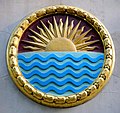History
In 1919, a committee chaired by the Marquess of Crewe determined there existed the need to separate the agency work of the India Office from its other political and administrative roles, and recommended the transfer of all such work to "a High Commissioner for India or some similar Indian Governmental Representative in London." It was also felt popular opinion in India would view this as a step towards full Dominion status for India. [5] The Government of India Act 1919 upheld the recommendations of the committee, making provision for "the appointment of a High Commissioner by His Majesty by Order in Council, which might delegate to the official any of the contractual powers of the Secretary of State [for India] in Council, and prescribe the conditions, under which he should act on behalf of the Government of India or any Provincial Government."
On 13 August 1920, King-Emperor George V issued the required Order in Council. Until India became independent in 1947, the post was styled "High Commissioner for India". The first High Commissioner for India was Indian Civil Service officer Sir William Stevenson Meyer; the first of Indian origin was Sir Dadiba Merwanji Dalal. The High Commissioner enjoyed the same status as his counterparts from the British Dominions. [5] Upon Indian independence the post was given the present designation.
Proposed in 1925 by the Indian High Commissioner Sir Atul Chatterjee, the building was designed by Sir Herbert Baker and completed in 1930. [3] It was formally inaugurated on 8 July 1930 by the King-Emperor George V. [3]
A bust of Jawaharlal Nehru was unveiled by Prime Minister John Major in 1991. [3]
This page is based on this
Wikipedia article Text is available under the
CC BY-SA 4.0 license; additional terms may apply.
Images, videos and audio are available under their respective licenses.
















